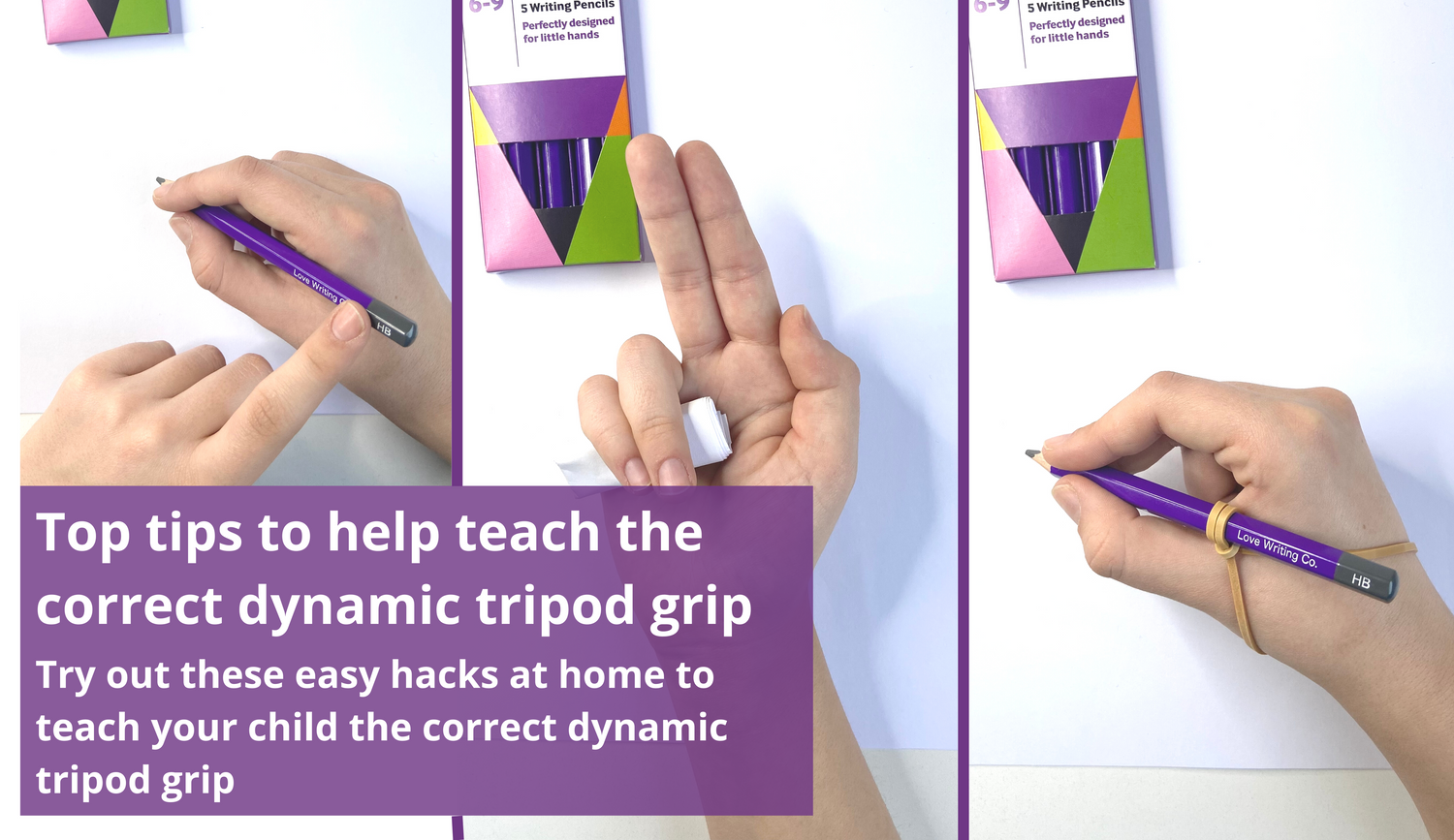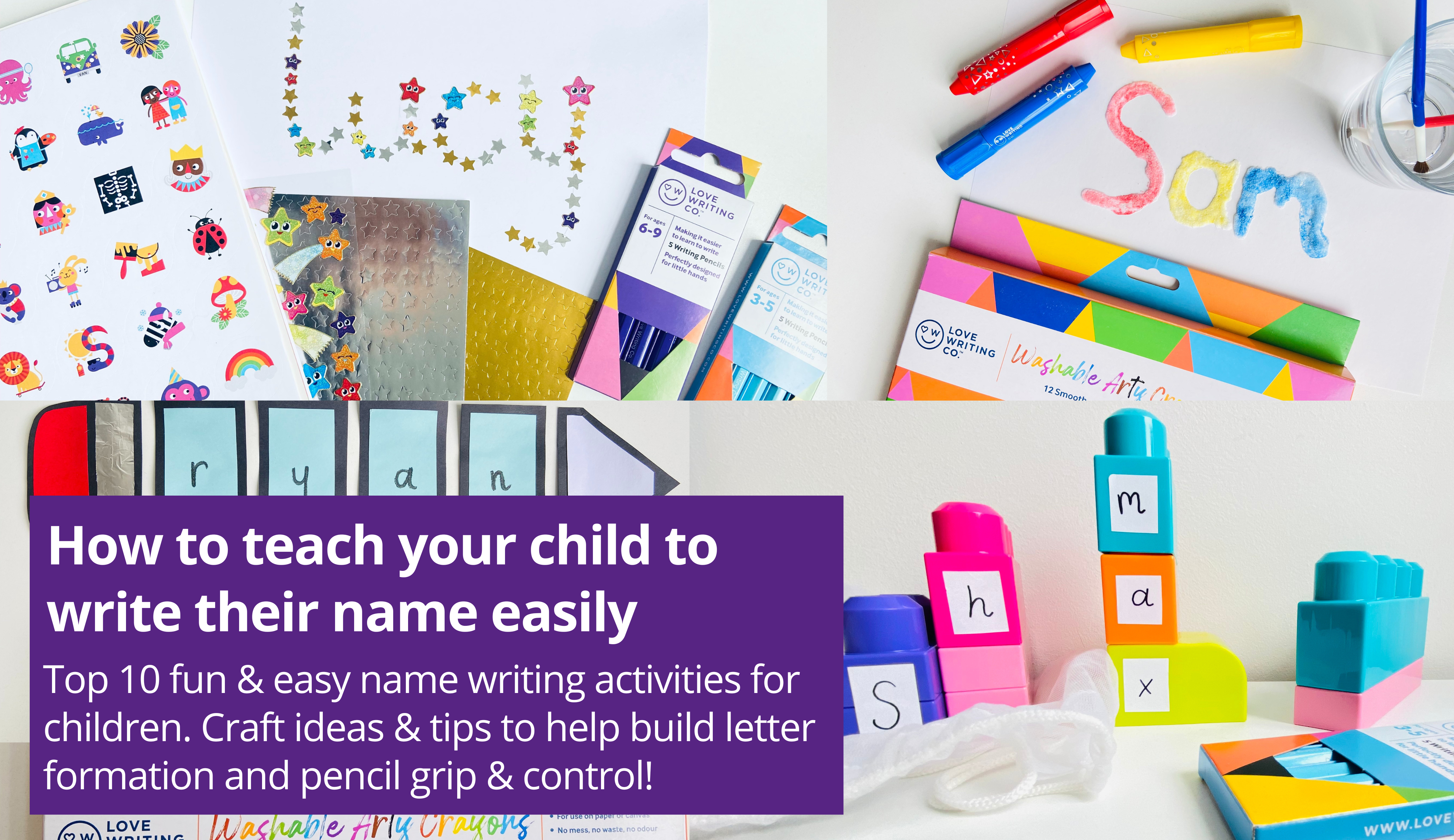It is so important to support your child when it comes to holding a pencil correctly. When your child holds their pencil with the correct dynamic tripod grip, it allows them to write more comfortably, more confidently and for longer with reduced hand fatigue.
As your child grows up, you will find the need for them to write more and more will become more prominent. For example, school exams - currently, many school exams are still written and require children to write for long periods of time.
Although we do live in an ever evolving world of technology, handwriting is still very much an essential skill for everyday life. Hence, why it is so important to support good writing habits from early on.
Keep reading to find out lots of fun and helpful tips and tricks of ways to encourage your child to adapt the correct tripod grip. We'll be covering:
-
Why having the correct Dynamic Tripod Grip is important for children?
-
The importance of improving your Early Learner's fine motor skills
-
The importance of improving your Early Learner's gross motor skills & posture to support their handwriting
-
3 Amazing MUST TRY hacks to try at home to help them adapt their dynamic tripod grip: Tutorials and demonstrations
In this article, you will also find links to really helpful writing resources that we here at Love Writing Co. have designed to encourage children to adapt the correct tripod grip.
Our most popular tools being our specially designed chunky tripod grip writing pencils for kids which have a unique hexagonal shape and are designed to be the correct length for ages 3-9. Shop yours here.
Did you know? All of our resources are also SEND friendly as well as being assured by the British Dyslexia Association and also support both left and right handed children.

1. Why is having the correct Dynamic Tripod Grip important for children?
You may find that if your child is not using the correct dynamic tripod grip, then it may be causing them a lot of pain, hand and muscle fatigue. You may be familiar with hearing "Mommy, Daddy... My hand hurts! I don't want to do it anymore!" - this could be a contributing factor as to why.
When your child feels pain from writing from incorrect pencil positioning and also not using the correct pencils for their hands, it increases their reluctancy to write because they simply would rather not be in pain - exactly how us as adults would feel.
That's why it is incredibly important for your child to try to adopt the correct dynamic tripod grip as best as possible in order for them to have a positive, comfortable and happy writing experience. If they enjoy it, they will want to do it = it is that simple!
Did you know?...
Love Writing Co. tripod grip writing pencils are designed to be the correct length and with a wider diameter, softer core and hexagonal shape, our pencils prevent muscle fatigue and encourage the correct tripod grip from the very beginning, promoting a love of writing from an early age.
Understanding the different stages of developmental grasp: WATCH our easy step-by-step guide here. Click to watch.
2. The importance of improving early learner's Fine Motor Skills
If your child is a little reluctant to practice or strengthen their fine motor skills, you may find that they in turn find it difficult to hold pencils correctly, for long periods of time or to manoeuvre pencils when writing fluidly.
What can you do at home to improve their fine motor skills?
Strengthening those little hand and finger muscles will improve dexterity and make it easier to adapt the correct dynamic tripod grip. There are so many fun and clever ways to help improve fine motor skills, especially encouraging the pincer grasp.
- Lego building blocks - stacking and popping them together is a great activity
- Threading pasta bracelets and necklaces
- Ask your child to help you hang out the washing and peg the clothes to the line
- Popping bubble wrap - any parcels? keep the bubble wrap and let them pop away!
- Peeling stickers (use Love Writing Co. Handwriting Practice Books which include FREE sticker sheet of 36 rewards stickers - peeling and sticking is a great fine motor and also eye co-ordination skill)
- Get creative! - A great way to improve motor skills is getting creative by colouring, drawing and painting using our washable arty crayons.
TOP TIP: Use our 3-in-1 Fine Motor Washable Arty Crayons for kids. With three creative uses; crayons, watercolours and pastels the artistic opportunity is endless.
These are excellent for improving fine motor skills and cause and effect with its twist barrel design and protective casing lids to pop on and off. Now on offer here.

3. The importance of improving your Early Learner's Gross Motor Skills & Posture to support their handwriting
Take a moment to just inspect the way your little one is sitting at their desks, their arm, elbow and feet positioning will have a lot to do with how well they can use their body strength for their fine motor skills and balance when writing.
TOP TIP: Always remember, the way your child sits at their desk and posture is JUST as important as how they hold their pencils!
Maintaining good posture ensures your body is in good alignment and that stress on your muscles, joints and ligaments are distributed evenly across your body. When sitting correctly, their hands, elbows and wrist are able to balance their posture correctly and allow them to write with ease.
Poor posture can cause increased strain on your body, leading to fatigue, tight or achy muscles in your neck, back, arms and legs, joint stiffness and pain.
A great way to improve posture and gross motor skills is by:- Use the guide below to remind your little one how they should be sitting at their desks and tables for maximum comfort - note these points as 'check points' to tick off when they are sitting down
- Ensure your child has the resources such as chair support and leg/feet support if required to sit up in position correctly.
- Use activities mentioned in section (2) above to improve gross motor skills such as threading beads, open and closing pegs
- Gentle squeezing exercises such as squeezing a ball - next time you're in the park, spend 10 minutes warming up and strengthening those hands and fingers before playing catch.
FOLLOW us on Instagram, Facebook, Tiktok & Youtube for more helpful tips @lovewritingco
4. Must Try At Home Hacks!
3 Amazing Tricks & hacks to try at home to Teach Dynamic Pencil Grip
Please note it is important to remember that all children develop at different stages and milestones. Supporting our children throughout their development is key!
If your child is struggling with remembering how to hold their pencil correctly, ask them to try out the 'pinch and flip' method.
Simply pick up the pencil with a pincer grip with the pencil facing towards them and gently flip it over so it rests between your thumb and pointer finger.

Fold up a piece of tissue or paper and tuck underneath your pink and ring finger. By doing this you are occupying the fingers that are not needed and preventing them from getting in the way. This will enable them to keep only the fingers they need to be around the pencil, around the pencil!

If you find that your little one starts off strong with their grip but the incorrect digital or static tripod grasp returns slowly, you should try the 'rubber band' method.
Firstly, you will need to attach and loop a rubber band around your pencil. Then, put your hand through the rubber band and wear it like a bracelet.
Place the pencil in the correct dynamic tripod grip on your child's hand (let them do it themselves if they are able to), and the rubber band should help to stabilise and keep it in place whilst writing.
Keep practising like this until it sticks! Once it sticks, simply remove the rubber band.

Resources to support your child's learning to write journey now on sale with special offers.
Shop Handwriting and letter formation workbooks here ages 3-9

Shop Tripod Grip Writing Tools here


We hope these tips help and we think you’d love to check out this article out too:
Visit our website to shop handwriting resources. www.lovewritingco.com
- Thanks for reading!
This article was created, Written & Owned (including illustrations) by Love Writing Co.







Leave a comment
All comments are moderated before being published.
This site is protected by hCaptcha and the hCaptcha Privacy Policy and Terms of Service apply.